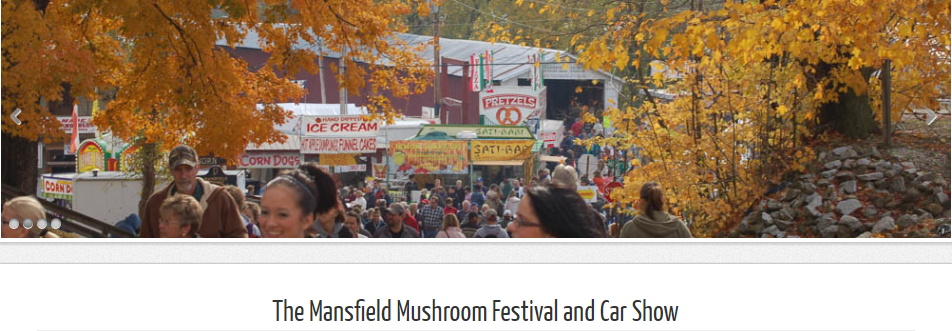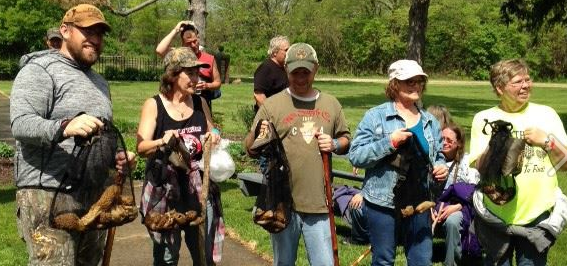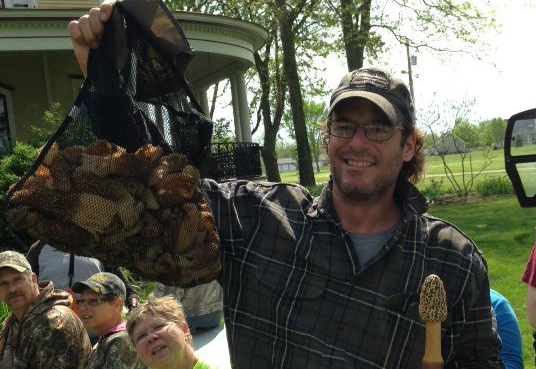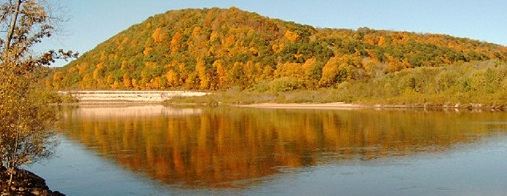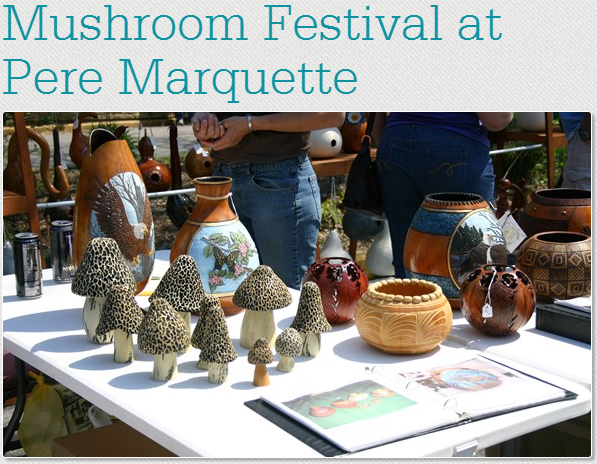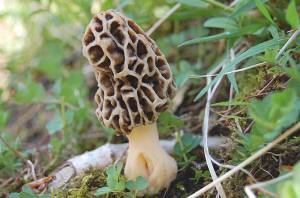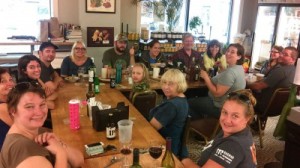In a stunningly inaccurate article published in the Chicago Tribune on August 2nd John McCabe, Director of Resource Management claims that swaths of Cook County Forest Preserves are being pulled up by foragers, both for profit and for personal use! Link at bottom, full text of the article beneath that.
Let me fill you in on my personal story about leading foraging tour in the Cook County Forest Preserves; At one point we would lead forays up to 20 people to teach them about wild mushrooms, and wild plants. We would identify species in situ without picking them, and much of the educational part of each foray was the history of the Cook County Forest Preserves, and what the law said about picking there, as well as how to sustainably pick both mushrooms and plants in areas in which it was legal.
Most of the information given was to prompt people to find their own woods, which ever forest preserve the could go to weekly, and push them to go weekly and become invested in that particular set of semi-wild. Each foray we gave each member a handled paper bag, and gave an award to the participant that took the most trash out of the Forest Preserve. Often if was an identification guide for local plants, mushrooms, or animals. Sometimes it was partnered with a fine bottle of wild made liqueur.
Our mission was to bring people to their local woods, and then convince them it was worth spending time in, and hoping that they would become invested that they would understand that our local woods are worth saving, and expanding, not just for nature walks, but with 13% of our land, a great expanse to mitigate climate change.
I think it was 2017, August, about five years ago that two fully armored and armed Cook County Forest Preserve Police Department officers walked into the butcher shop I managed, Carnivore Oak Park.
It was a Saturday, a day I usually didn’t work but because I usually had weekends off I would trade with my coworkers on weekends that I didn’t have my kid. They milled around the door looking at the smoking wood, looking at the freezer. I noticed them and thought it was weird. Finally one came over to the beef case where I was stationed, the other covered the room with his hand on his gun. He asked me if my name was Robert Poe. Of course I said yes. He frowned and said, “We’ve found your blog.”
Fantastic my blog wasn’t getting many hits in 2017, but he was much more serious that my flippant smile. He asked if they (the second officer came over after I put the butcher knife down, after cutting the tri-tip out of the round) and smiled.
I agreed and sat down at the lunch table between the cases, both of them backed to the beef case with their shooter glasses and full woodland camo armor (with leg shields!). They told me all about the blog and how I had been taking people to the Cook County Forest Preserves for foraging trips. And that they had to take me in that day.
I told them that I had done nothing wrong, and if bringing 20 people (25 or more you need a permit) at a time to the woods to educate them about foraging was completely legal. They then told me that mushroom picking was illegal, and they could arrest me for that. I took the time to look up the law, and show that to them. They began to be fairly unhappy.
At this point they told me that if I no longer took people into the woods on foraging trips the would let everything go. At this point I told them that I would continue to bring people into the woods, that I would extoll the virtues of the land we hold in common, and that I would continue the mission of the Cook County Forest Preserve District, to educate and inspire, to bring future generations to connect and find valuable future generations into appreciating preserving our common land.
The officers were very upset. They left by the front door after about 20 minutes of my extolling the virtue of bringing people to the woods, and also reciting the law. I actually had to use concise knowledge of both the law, but of the future that we should have.
My hands were shaking, I knew I had won, but having a couple muscular gung ho cops who find you the enemy, and show up to your workplace is quite upsetting, regardless if you manage to walk away. But in the coming years they were successful, I only took a few corporate tours to the Cook County Forest Preserves, denying hundreds of a good education on sustainable foraging, and quashing my first amendment rights to teach.
I was a smoker at the time, I left the back door and lit a cigarette, and then looked to the street, there was a fully armored Cook County Forest Preserve Officer punching the trunk lid of his unmarked squad cad, over and over and over. While he got his anger out because he was one upped by someone who knew the law, I was literally shaking for over an hour. Let’s say the visit left me not so good a manager of that butcher shop that Saturday.
Let’s look at the facts. The Cook County Forest Preserve was originally founded so land owners how had farms and homes in flood plains would get the gift of a purchase from a government entity that would bail them out. The entity would ensure that no other building would be built on the flood plain. The official history will tell you that it always had preservation, but as a Life Scout I traversed most of the Southwestern Cook County Forest Preserves finding many farmhouse foundation, middens, and other evidence of previous 19th and 20th century farms.
The mission of the Cook County Forest Preserve District has thankfully changed over the last 100 or so years, and as the land owner of 13% of Cook County many preserves have excellent volunteer stewards that lead hundreds of volunteers to clear invasive species. Amazingly Cook County voters gave themselves an extra $18.00 a year tax to support the fantastic programs of the CCFPD.
Where does that extra $40,000,000 a year go? Well it’s hard to tell from the budget, there are no real line items, sure the executive summary lets you know that 43 lakes and ponds are stocked, and have fishing programs, but there is no easily read line item for which stocking fish costs, there is no line item that calls out the number of man-hours used in stocking those fishing spots. The budget talks about hundreds of millions in improvements, including to new and improved fishing spots.
I fully support more money on trails, walking paths, fishing spots, and all of the other things that the CCFPD is attempting to do with the $40,000,000 that I worked to have my neighbors vote for. It’s frankly impossible to know where the money went.
The problem I have with this is that the Cook County Forest Preserve District has a mission:
- Preservation: The Forest Preserves acquire, restore and manage land to preserve public open space and the habitats that wildlife and plants need to thrive.
- Education: The Forest Preserves provide environmental education programming for all ages, with a particular focus on offering information and experiences that will inspire the next generation to take responsibility for protecting the land, plants and wildlife of our region. Recreation: Not only are the Forest Preserves close to home, but they are also fun and affordable, offering accessible recreation opportunities to all residents of Cook County.”
I would like to form an ad hoc group of foragers in order to format an open letter to the Cook County Forest Preserve Board, that have a scientific background on why bringing people to the woods allow them to be invested in place.
I would like the Cook County Forest Preserve District to spend the same amount of money as they spend on fishing programs spent on foraging programs that feature the 14 invasive edible species, as well as the “Fool Proof Four, Plus Two More”
First order is to gather folks that will work as an ad hoc committee, to kick around ideas.
Cook County Ordnance
Notice fungi kingdom not on this list.
2-2-1: – PROTECTION OF NATIVE LANDSCAPE.
A.Destruction of Native Landscape: No person shall, within the property of the Forest Preserve District:1.Cut, remove or wantonly destroy any tree, sapling, seedling, bush or shrub, whether alive or dead, or chip, blaze, box, girdle, trim, or otherwise deface or injure any tree or shrub, or break or remove any branch, foliage, flower on any tree or shrub, or pick, gather, uproot, remove or destroy any flower, plant or grass.2.Remove or cause to be removed any sod, earth, humus, peat, boulders, gravel or sand.
3-3-14: – INJURY OR DESTRUCTION TO FOREST PRESERVE PROPERTY.
No unauthorized person shall in any Forest Preserve:
A.Destroy, cut, break, deface, mutilate, injure, disturb, sever from the ground or remove any sod, earth or growing thing including, but not limited to, any plant, flower, flower bed, shrub, tree, growth, or any branch, stem, fruit, or leaf thereof; or bring into or have in his/her possession in any Forest Preserve any tool or instrument intended to be used for the cutting thereof, or any garden or agricultural implements or tools which could be used for the removal thereof except as approved and allowed by permit; Penalty: Any person violating any of the provisions of this Subsection shall be fined not less than seventy-five dollars ($75.00) or more than five hundred dollars ($500.00) for each offense.
Some very wishy washy language that has never been upheld.
3-2A-11: – ADMINISTRATIVE RULES AND REGULATIONS.
The General Superintendent shall have the right from time to time to issue administrative regulations relative to the provisions of this Article.
(1989 Code)
ARTICLE BELOW
https://www.chicagotribune.com/news/environment/ct-poaching-foraging-forest-preserves-20230801-fyar4djpdvbuvnh5pum7tifpaa-story.html?fbclid=IwAR2z23UKvBTEAWQnKHwwlG52WjIHJLM7QM-ateaG9YbS6BMPYIjcAvF5DF4
ENVIRONMENT
Plant poachers damage Cook County forest preserves as demand for ramps and morels makes foraging more profitable
By Ezra Maille
Chicago Tribune
Published: Aug 01, 2023 at 5:00 am
Paul Roots, a resource technician with the Cook County Forest Preserve, clears away brush and invasive plants along the shores of Baker’s Lake on July 31, 2023, in Barrington. Roots and other workers who spend time in the forest preserve keep a lookout for people foraging and poaching vegetation.Paul Roots, a resource technician with the Cook County Forest Preserve, clears away brush and invasive plants along the shores of Baker’s Lake on July 31, 2023, in Barrington. Roots and other workers who spend time in the forest preserve keep a lookout for people foraging and poaching vegetation. (Stacey Wescott/Chicago Tribune)
When you think about poaching, ramps are likely not the first thing that come to mind.
But as foraging has grown in popularity, plants including ramps, a popular wild onion, and mushrooms such as morels are frequently targeted by poachers to sell to Chicago-area restaurants.
Poaching constitutes removing anything that naturally occurs in the forest preserves, from catching animals to collecting edible plants to picking flowers. The simple act of removing a plant can have unforeseen repercussions and disrupt the ecosystem.
“Most people think it’s a harmless act,” said Martin Hasler, deputy chief of the Cook County Forest Preserves Police Department. “The forest preserve is for all of us and taking away anything from it disturbs the forest preserve from its natural state.”
Poaching in the forest preserves has always been an issue, but the rise of foraging is changing how it’s done, said John McCabe, director of resource management with the Cook County Forest Preserves. He said forest preserves employees have found swaths of land where plants have been pulled up or destroyed completely.
McCabe credits social media for the increase in foraging, the practice of gathering plants and sometimes animals for consumption or profit. He said people who frequent the forest preserves will often post about where they went and what they gathered, leading to others following in their footsteps.
Some gather small amounts of plants for personal use, but the majority of foraging is strictly for profit, Hasler agreed.
“There is a market for that,” Hasler said. “They know where to go, they know what they’re looking for and they know where to take it once they get it.”
Foraging can be done sustainably, but oftentimes foragers decimate an area, filling up trash bags full of edible plants to sell across the city, McCabe said.
Marty Bechak, a senior resource technician with the Cook County Forest Preserve, works along the Poplar Creek Bike Trail and clears away brush, July 31, 2023, in Hoffman Estates. Belchak and other workers watch for poachers. “You don’t want to punish people, you want to educate them. Most people just don’t know,” he said.Marty Bechak, a senior resource technician with the Cook County Forest Preserve, works along the Poplar Creek Bike Trail and clears away brush, July 31, 2023, in Hoffman Estates. Belchak and other workers watch for poachers. “You don’t want to punish people, you want to educate them. Most people just don’t know,” he said. (Stacey Wescott/Chicago Tribune)
“Restaurants like locally grown stuff and what they don’t know, or in some cases maybe they do, is that these things are being collected illegally in the forest preserves,” McCabe said. “Even though we have healthy populations of these types of plants, in a county with a population of 5.2 million people, if this were to get out of hand, you could devastate these populations in a very short period of time.”
Dave Odd, a professional forager who runs Odd Produce, a foraging organization that sells naturally occurring edibles and offers foraging tours, supplied Chicago restaurants with foraged foods for roughly 10 years. He said it was challenging to run a business where one week he could sell $800 worth of food and the next week sell nothing, as owners and chefs would still be fully stocked.
[ Foraging walk near Montrose Beach teaches residents about edible plants they didn’t know grew in the heart of the city ]
During this time, Odd found his foraged goods where he could, in street alleys, roadsides and anywhere else in the city where plants grow.
“Everyone that’s into foraging at some point has definitely taken something from somewhere they wouldn’t have, shouldn’t have or weren’t supposed to,” Odd said.
At the height of his business, Odd worked with around 40 businesses on a weekly basis. He supplied chefs with fairly specific ingredients who were willing to add something to a current dish or craft a special depending on the season.
Ramps are one of the most popular picks, Odd said, and make up the primary species in the Chicago area that could be overharvested.
The city’s name is even derived from the Native American word “chicagoua,” which refers to a wild-growing, stinky onionlike or garliclike plant — believed to be the same plant as the ramp.
Kevin Erickson, senior manager of sustainable agriculture at Loyola University, teaches urban agriculture and conservation practices and is an active forager. He said he enjoys foraging for mushrooms in particular and doing it sustainably is key.
“There’s a good reason why it’s illegal to pull these things out of parks and forest preserves,” Erickson said. “If everyone wanted to do that, it’d be gone.”
Sustainable practices include marrying invasive species removal with edible foraging, avoiding overharvesting, not picking young plants which haven’t had a chance to flourish and leaving at least 25% of the plant or patch, according to Erickson. This allows plants to continue living and thriving, able to bounce back in just a few days so long as they aren’t decimated.
“A lot of these plants are long term, they may take several years to be able to harvest,” Erickson said. “Ramps is a great example. Overharvesting can be commonly done because we get really excited finding something. We feel like we have to have it and if we don’t take it, someone else will.”
Ramps, or wild onions, are harvested on private property in a forest near Baroda, Michigan, in 2015.Ramps, or wild onions, are harvested on private property in a forest near Baroda, Michigan, in 2015. (E. Jason Wambsgans/Chicago Tribune)
Catching poachers in the act within the confines of the 70,000 acres that make up the forest preserves has proven to be difficult. When a volunteer or visitor spots poaching taking place, they can call the forest preserve police, but more often than not, the poacher gets away before law enforcement arrives. Foragers have been known to drop their collecting bags and run.
In these instances, while the poacher may not have gotten away with their prize, the vegetation they collected typically can’t be replanted.
Those that avoid reprimand, McCabe said, typically take a more secretive approach: parking in a nearby neighborhood, pulling off on the side of the road and hiding collecting bags from other preservegoers.
Depending on the act, poachers can be cited and fined $75 to $500. With an estimated annual 62 million visits each year, the forest preserve staff says permitting for foraging or collecting would not be financially or ecologically feasible.
The preserve Police Department employs four full-time detectives who follow up on every poaching report. Since the staff isn’t able to write a lot of citations for poachers in the act, McCabe said it’s hard to say how many poachers regularly pass through the preserves.
“Most people want to do the right things and are doing the right things out here,” McCabe said. “They know they shouldn’t be out here collecting.”
For foragers, while picking from the right area ensures plants won’t be overharvested or poached, adhering to sustainable practices remains crucial for the success of the harvested habitat.
“The biggest part of foraging is you’re walking in wild spaces,” Erickson said. “Whether you’re consuming the food or not, there’s still a lot of benefits that go with the experience of being out in these spaces. We want to value them and not just think of them as resources for food.”
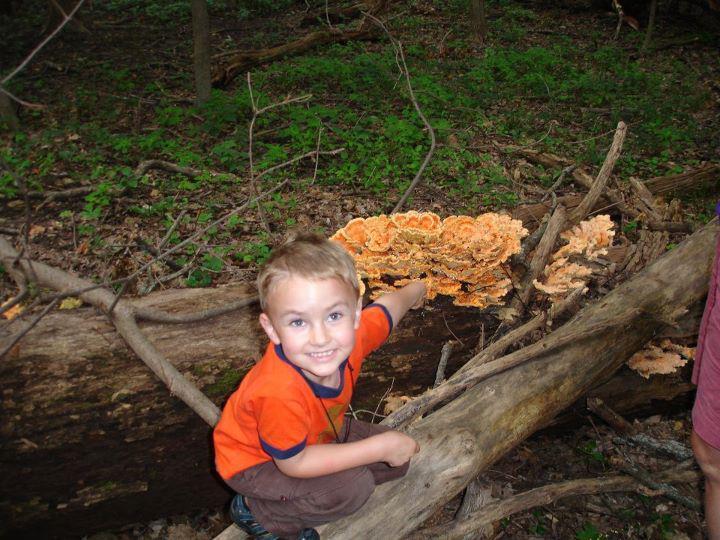
 On Saturday, September 21st well be meeting at Hufendick Farm Market, 24032 Lockport Street in Plainfield, IL at 10:00. We’ll leave promptly at 10:30 and head to a local woods. Rob Poe and Dave Odd of “Eat the Neighborhood” will lead the foray, identifying edible mushrooms and edible wild plants.
On Saturday, September 21st well be meeting at Hufendick Farm Market, 24032 Lockport Street in Plainfield, IL at 10:00. We’ll leave promptly at 10:30 and head to a local woods. Rob Poe and Dave Odd of “Eat the Neighborhood” will lead the foray, identifying edible mushrooms and edible wild plants.
















